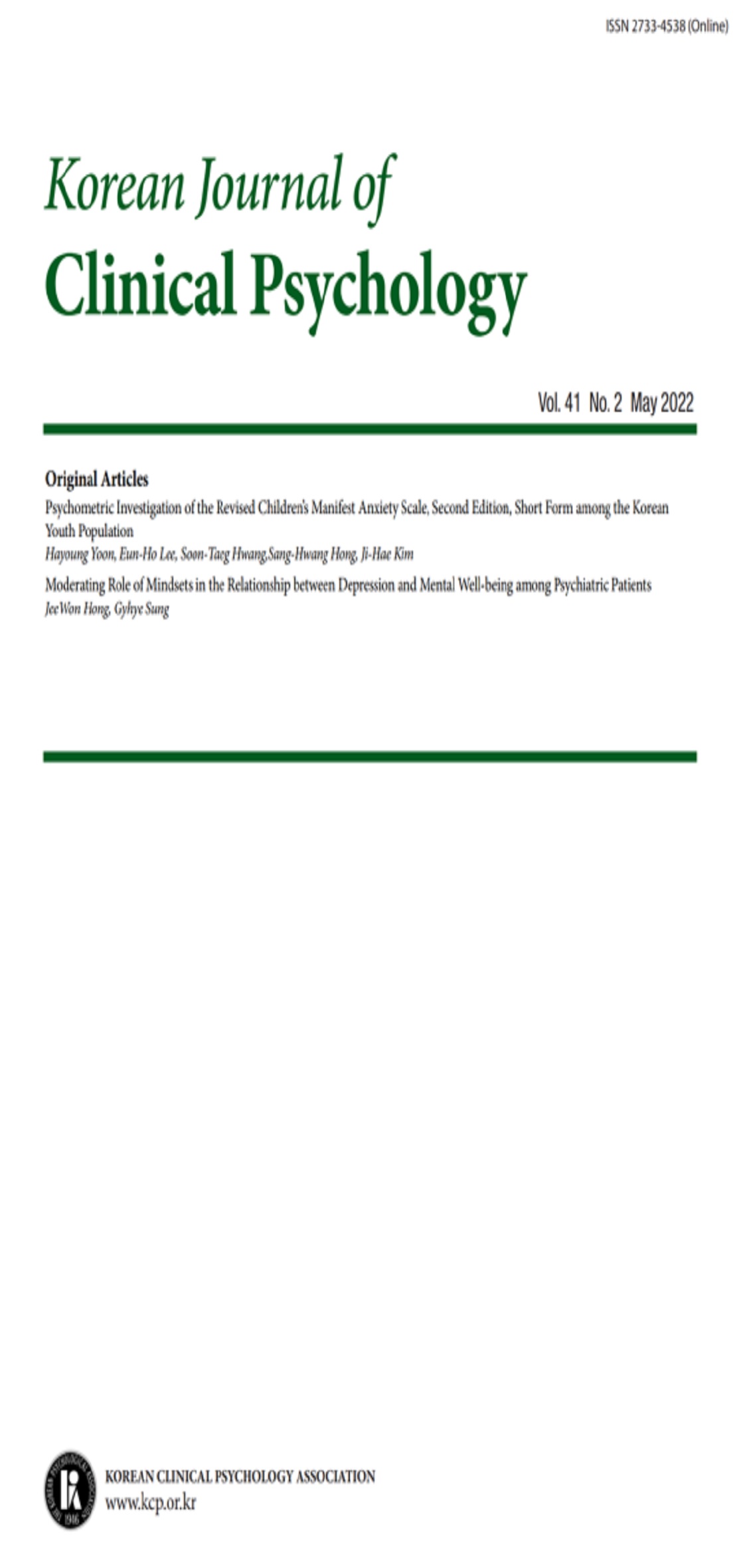open access
메뉴
open access
메뉴 E-ISSN : 2733-4538
E-ISSN : 2733-4538
본 연구는 사회불안에 대한 자기제시 모형(Leary & Kowalski, 1995; Schlenker & Leary, 1982)의 자기제시 동기 요인에 대해 검토하였다. 성향적 자기제시 동기가 높은 사람들은 대인간 평가가 예상되는 상황에서 사회불안을 높게 경험할 것이라고 가정하고, 이 가설을 검증하였다. 대학생 피험자들은 자기제시 동기 척도에 의해 자기제시 동기가 높은 집단과 낮은 집단으로 분류되었으며, 대인간 평가가 예상되는 상황(평가조건)과 그렇지 않은 상황(통제조건)에서 자기에 관한 이야기를 하였다. 연구 결과, 자기제시 동기가 높은 집단은 평가조건에서 통제조건에 비해 사회불안의 정서적 반응을 반영하는 상태불안 점수가 더 높았으나, 자기제시 동기가 낮은 집단에서는 이러한 차이가 없었다. 사회불안의 행동 측정치인 발언시간, 발언속도 및 이야기의 내용 적절성에서는 일관된 결과를 보여주지 못하였다. 사회불안을 인지적-정서적 반응으로 정의하는 관점에 따르면, 본 연구 결과는 자기제시 모형이 가정한 대로 자기제시 동기 요인이 사회불안의 주요한 원인으로 작용함을 시사하는 것이다.
The present study explored the effects of dispositional self-presentational motivation and interpersonal evaluation on situational social anxiety. It was hypothesized that people with high self-presentational motivation who are faced with the prospect of interpersonal evaluation will experience high social anxiety. Subjects who scored high or low on a measure of self-presentational motivation were asked to tell four stories about themselves to an interviewer in the anticipated-evaluation condition or in the anticipated-no-evaluation condition. As predicted, subjects with high self-presentational motivation reported higher state anxiety in the evaluation condition than in the control condition, but subjects with low self-presentational motivation didn't. Stories of subjects with high self-presentational motivation were less appropriate in the evaluation condition than in the control condition, but subjects with low self-presentational motivation didn't. Inconsistent results were found in speech duration and speech speed. According to the perspective that social anxiety is defined as cognitive-affective responses excluding behavioral responses, the findings of this study suggest that self-presentational motivation is an important cause of social anxiety.
(1995) 대인불안의 측정에 대한 연구,
(1998) 대인불안에 대한 자기제시 동기와 자기제시 기대의 관계,
(1996) Spielberger의 상태-특성불안 검사 Y형의 개발,
(1987) Attributional responses of anxious individuals to different patterns of social feedback:Nothing succeeds like improvement,
(1991) Social standards and social withdrawal,
(1980) Diagnostic and statistical manual of mental disorders,
(1989) Journal of Personality and Social Psychology,
(1986) Effects of performance expectancy and self- focused attention on social interaction Journal of Personality and Social Psychology,
(1995) A cognitive model of social phobia, Guilford Press
(1992) Nonverbal behavior and self-presentation,
(1990) Responses of the socially anxious to the prospect of interpersonal evaluation,
(2001) Information processing in social phobia:A critical review,
(1983) Social anxiousness:The construct and its measurement,
(1990) Impression management:A literature review and two- component model,
(1995a) Social anxiety, Guilford Press
(1995b) The self-presentation model of social phobia, Guilford Press
(1990) Handbook of social and evaluation anxiety, Plenum Press
(1993) Focus of attention and social anxiety:The role of negative self-thoughts and perceived positive attributes of other,
(1993) Journal of Personality and Social Psychology,
(2003) The etiology of social phobia: Toward a developmental profile,
(1995) Descriptive psychopathology of social phobia, Guilford Press
(1997) A cognitive-behavioral model of anxiety in social phobia,
(1982) Social anxiety and self-presentation:A conceptualization and model,
(1985) Social anxiety and communication about the self,
(1992) Interpersonal processes involving impression regulation and management,
(1992) Comorbidity and morbidity in epidemiological sample Archives of General Psychiatry,
(1983) Manual for the State-Trait Anxiety Inventory, Consulting Psychologist Press
(2002) Self-focused attention in social phobia and social anxiety,
(1993) Cognitive processes in social phobia,
(1996) Effects of focus of attention on anxiety level and social performance of individuals with social phobics,
